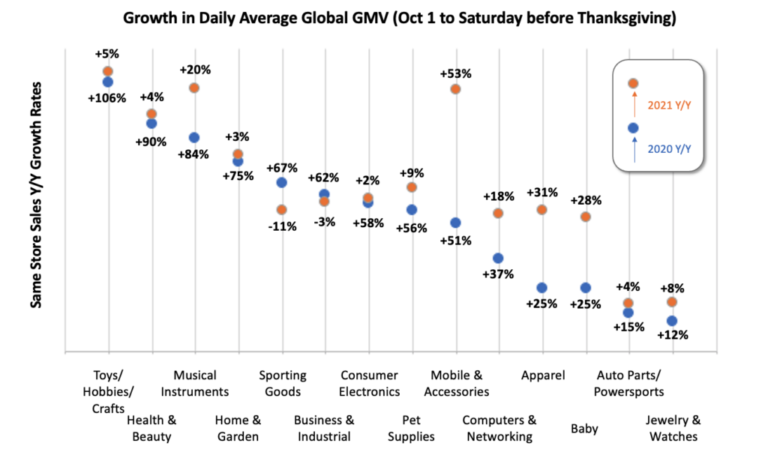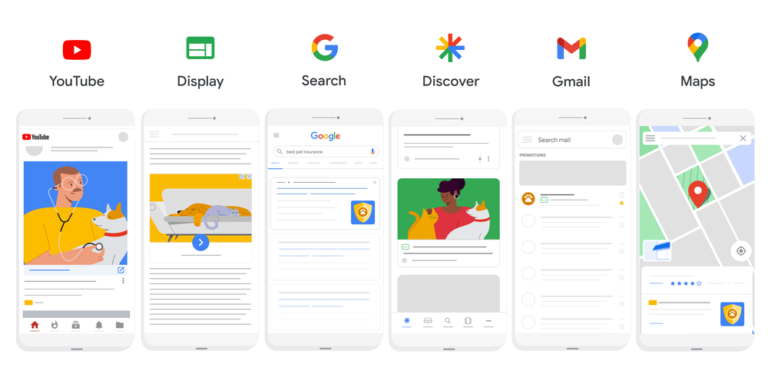If you want to capture a slice of those massive holiday retail sales and beat out your competitors, you must start planning your holiday campaigns now. If you don’t start today, you’ll fall behind other brands in your industry.
Five Steps for Optimizing Your Product Content
One of the best ways to get started with your holiday ecommerce campaigns is to lean into and learn from recent holiday retail trends.
Namely, stats show that most retail sales are heavily influenced by digital consumer and brand interactions, and 58% of U.S. retail sales will be digitally influenced.
If you want to stand out in the crowd of retailers vying for consumer attention, you must find unique, powerful, and emotional ways to connect via your product content.
Learn how to drive sales by optimizing your product content in five steps.
Step 1: Leverage the Power of User-Generated Content
User-generated content (UGC) is taking over in the digital marketing world. This shift is the primary reason why platforms like Snapchat, YouTube, Instagram, and TikTok are quickly innovating to cater more and more to creators.
Stats support the UGC craze, as 93% of buyers say they find creator content useful when making a purchase.
Since creator content is widely powerful when it comes to influencing purchases, it’s wise to strategically highlight creator content where it counts most: your direct-to-consumer (D2C) website and product pages across the digital shelf.
How to Turn UGC Into Product Content
Here are some creative ways brands can and do incorporate UGC into product content.
- Authentic visuals: Include authentic visuals of your products from influencer social media accounts on your website.
- Video testimonials: Add video customer testimonials to your product description pages.
- Unique hashtags: Share a unique hashtag on your site that customers can use to generate excitement about your products.
- Social media challenges: Highlight a social media challenge in your product content that encourages product and brand engagement.
- Brand advocates: Ask your favorite brand advocate to curate a collection of your products to share on your site.
Step 2: Add Reviews to Your Product Pages
Customer research on the power of reviews tells a consistent story — reviews influence purchasing decisions.
The Power of Reviews: A Research Breakdown
- 93% of customers say online reviews have an impact on their buying decisions, according to Podium.
- Most (72%) of customers won’t make any purchases until they’ve read reviews, according to Testimonial Engine.
- The overwhelming majority (92%) of consumers trust recommendations from people they don’t know over branded content, according to Nielsen.
Although research shows customers trust other consumers over the brand’s voice, ecommerce websites are traditionally full of highly produced images and in-house, take-our-word-for-it product copy.
Since reviews are so influential in purchasing decisions, it makes sense to focus your time and energy on capturing more reviews.
An even better idea for brands is to add reviews to the place on your website where consumers are getting ready to buy: your product description pages.
Reviews on your product detail pages (PDPs) offer a third-party product endorsement, adding incentive to persuade customers to buy.
Step 3: Provide Engaging Experiences With Enhanced Content
Leading customers through the purchasing funnel is all about providing an outstanding customer and user experience.
An integral part of the customer experience is creating a digital shopping experience that visually mimics the in-store shopping experience.
In other words, your PDPs should offer the same detail that a consumer could get from physically walking into a store and picking the product up off the shelf.
The best way to capture every visual detail is with enhanced content, which includes engaging image galleries, graphics, videos, comparison charts, and more.
The excellent news is enhanced content increases conversion rates by 10% in most categories and delivers a high-quality customer experience across the digital shelf.
As you get ready to optimize your digital shelf in preparation for the holidays, here are some types of enhanced content to consider adding to your product pages.
Telling your brand story and visually showing product uses and functions will help you stand out this holiday season.
Engaging Enhanced Content for PDPs
- Professional images
- Helpful and engaging branded videos
- Close-up product shots
- Pictures of different colors, fabrics, etc.
- Rotating images of how the product looks on different models
- Image galleries
- How-to videos
- In-depth product details and uses
- 360-degree image spins
- Zoom-in and zoom-out functionality
- Comparison charts
- Downloadable manuals and other content
Step 4: Give Your Product Pages Some Holiday Charm
Delivering a stellar user experience doesn’t start and end with visuals. It also includes providing every written detail a consumer might want to know and unifying your descriptions across all your commerce platforms.
It’s also critical to note that when there are issues with product content, 79% of consumers won’t make a purchase, according to the 2020 Salsify Consumer Research Report.
This holiday season, brands that prioritize, organize, and optimize their product content, including copy, across the digital shelf will win over brands that don’t.
Tips for Writing Product Descriptions
When it comes to optimizing your product detail copy, here’s where to focus your efforts.
Write to Customer Demands
Consider what content would be most valuable to your customers’ shopping experiences and what information people want to know. Then, preemptively answer those questions on your product pages.
Include All Relevant Product Details
Customers want to know every detail about your product. Good product descriptions include:
- Brand information
- Product names
- Titles
- Information about sizes, colors, dimensions
- Ingredients
- Sustainability practices
- Product categories, etc.
Centralize Your Product Copy
Successful brands centralize their product copy to develop a complete and consistent story across the digital shelf.
It’s strategic to create focused and detailed product copy for each of your products and then invest in a product information management (PIM) system to help you manage and distribute your content effectively.
The last thing to keep in mind as you revisit your product copy is that you should optimize it often.
As the holiday season is approaching, rewrite your product copy to include a celebratory holiday flair and relevant, holiday-focused keywords.
Step 5: Optimize Product Pages for Holiday Search Terms
Search engine optimization (SEO) plays a massive role in whether or not consumers will find your products during the holidays in the first place.
The majority (87%) of shoppers begin their buying journey with a search, according to Salesforce.
While most shoppers are searching for products, stats from the current Catalyst “State of Ecomm 2021” report show that only 35% of brands optimize their PDPs for search.
How to Optimize Your PDPs for Holiday Search Terms
These stats paint a clear picture of an open opportunity for ecommerce brands to get more sales from search engines.
If you hyper-target your PDPs for holiday SEO, you can beat out your competitors and capture the attention of interested consumers.
Conduct Seasonal Keyword Research
Take a deep dive into the data and audit product titles and descriptions. Add trending keywords to your product descriptions (e.g., gifts for dad, great stocking stuffers, gifts for women, etc.).
Capture the Voice of the Customer
Successful SEO is as much about incorporating the voice of the customer as it is including the right keywords.
Consider interviewing customers to find out how they talk about your product. Another idea is to add customer reviews to your PDPs.
Refresh your product content to reflect how customers are talking about your products, especially during the holiday season.
Take Up More Search Engine Results Pages (SERP) Real Estate
One of the most under-rated SEO strategies for ecommerce brands is adding schema markup to your product description pages.
A schema markup involves implementing structured data on your product pages to help Google better understand your product details.
You can add structured product data like price, style, availability, and more.
Armed with this information, Google can include more information about our products on its SERP, providing a more extensive, more detailed, and more eye-catching Google product listing.
Stay Ahead of Competition
By paying attention to holiday shopping trends and optimizing your product pages, you can drastically improve your performance and customers’ shopping experiences.
Don’t let your competitors get a leg up this season — show them up with a little holiday flair.
Download this holiday ecommerce checklist to learn how to quickly launch a winning holiday ecommerce strategy for winter success on the digital shelf.



